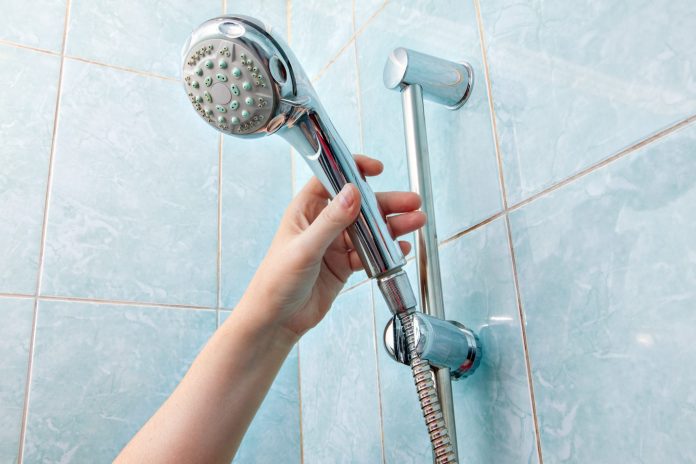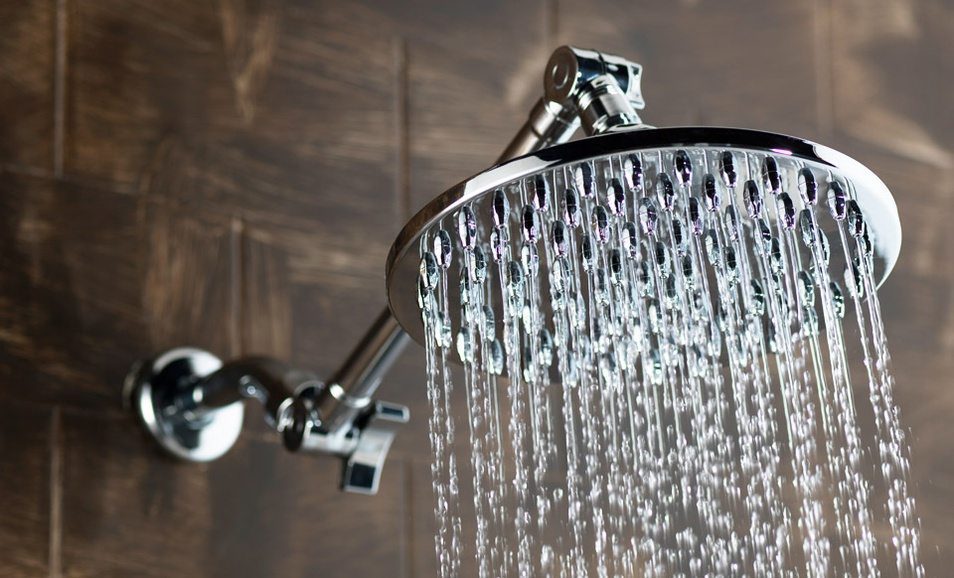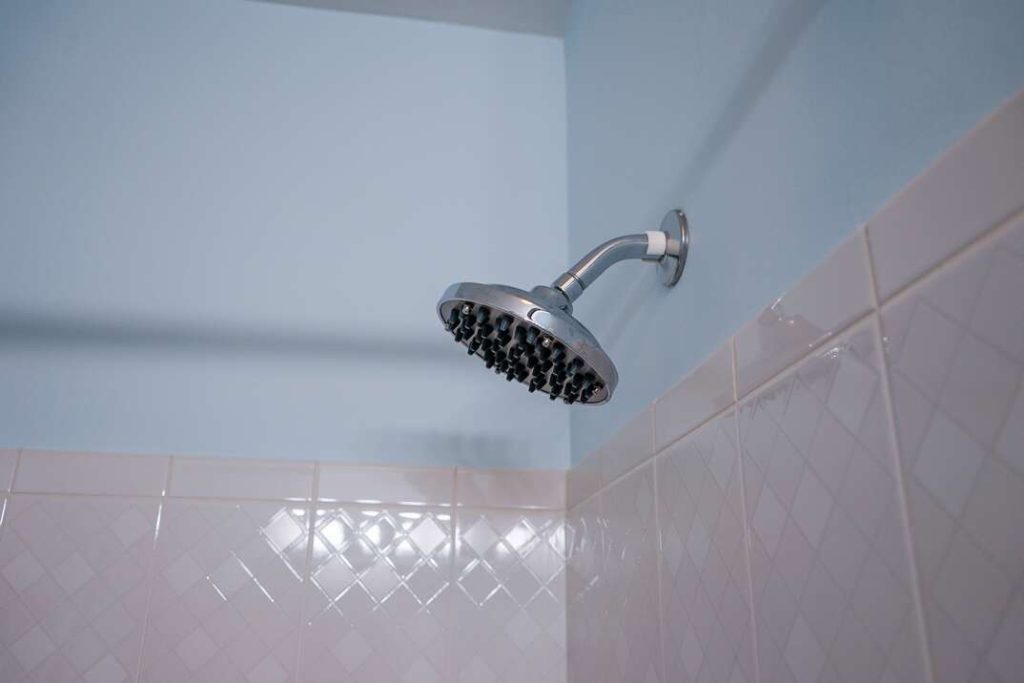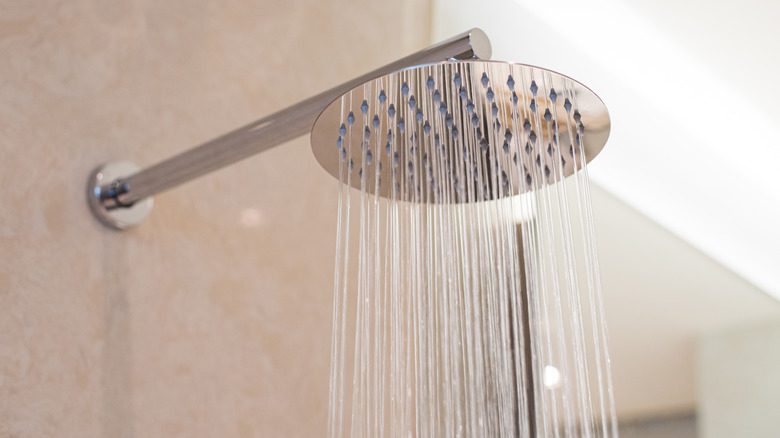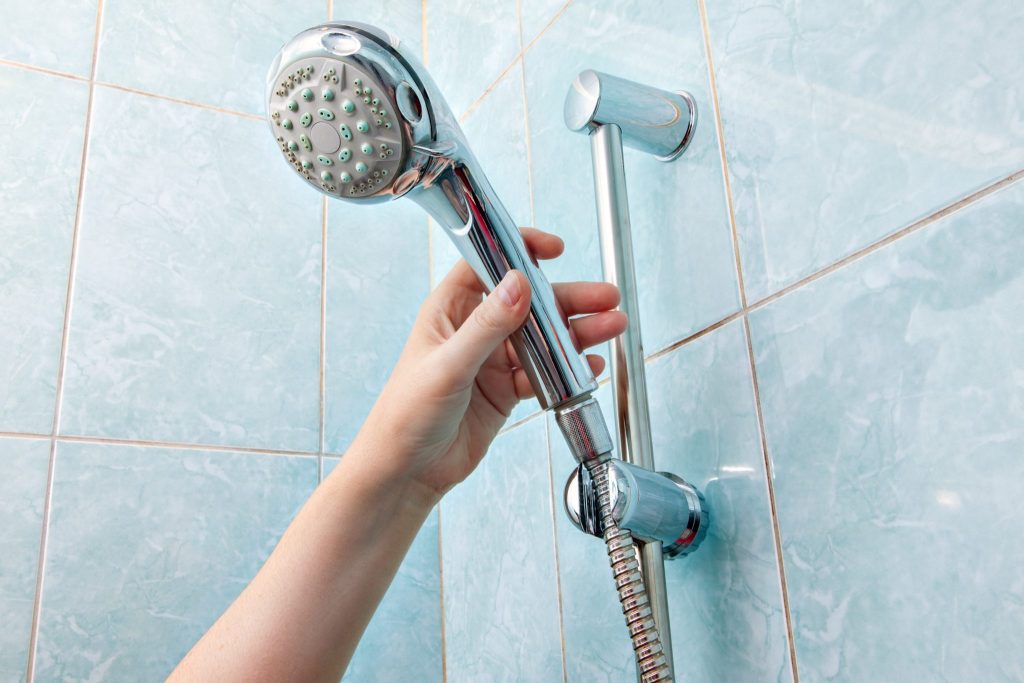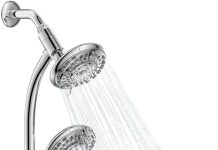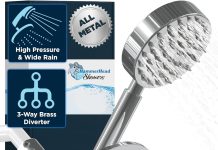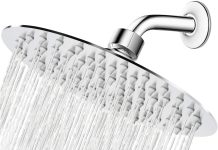Have you ever thought about how often you change your shower head? It’s one of those small but essential components in our daily routines that often go unnoticed.
We rely on our shower heads to provide a steady stream of water, helping us feel refreshed and rejuvenated.
But have you considered that over time, your shower head can become less effective, accumulating mineral deposits that reduce water pressure and hinder the ultimate shower experience?
In this article, we will explore the importance of regularly changing your shower head and how it can improve your daily showers.
So, let’s dive in and discover why it may be time for a shower head upgrade!
Table of Contents
Reasons for changing your shower head
Poor water pressure
One of the main reasons to consider changing your shower head is if you are experiencing poor water pressure. It can be frustrating to step into the shower and feel like you’re standing under a trickle rather than a rejuvenating stream of water.
Over time, shower heads can become clogged with mineral deposits and sediment, decreasing water pressure. Replacing your shower head can restore optimal water pressure and truly enjoy your showering experience.
Leaking or dripping
Another sign that it’s time to change your shower head is if you notice any leaks or drips. Not only can these be annoying and wasteful, but they can also contribute to water damage and mold growth in your bathroom.
Leaks and drips can be caused by worn-out seals or other internal components in the shower head. By replacing your shower head, you can ensure a leak-free showering experience.
Build-up of mineral deposits
Over time, mineral deposits can accumulate in your shower head, especially if you live in an area with hard water. These mineral deposits can restrict the flow of water and affect the performance of your shower head. Additionally, they can also contribute to the growth of bacteria and mold. By changing your shower head and selecting one with anti-clogging features, you can prevent the build-up of mineral deposits and improve the overall hygiene of your bathroom.
Appearance and style
If you want to update the look and feel of your bathroom, changing your shower head can be a simple yet effective way to achieve this. Shower heads come in various styles, finishes, and designs, allowing you to select one that matches your aesthetic and complements your bathroom decor. Whether you prefer a sleek and modern look or a more traditional and elegant style, there is a shower head out there to suit your tastes.
Health and hygiene concerns
Lastly, if you have concerns about the water quality of your shower head, it may be time for a change. Older shower heads may harbor bacteria, mold, and other pathogens that can harm your health. Investing in a new shower head with features such as antimicrobial protection or water filtration ensures you’re showering in clean and safe water.
Factors affecting the lifespan of a showerhead
Quality of the shower head
The quality of the shower head itself plays a significant role in determining its lifespan. Higher-quality shower heads tend to be made from durable materials less prone to wear and tear. Additionally, they often have better internal components that can withstand regular use and exposure to water. Investing in a reputable brand known for producing durable and long-lasting products is worth investing in when considering a new showerhead.
Water quality
The water quality in your area can also impact the lifespan of your shower head. Live in an area with hard water, which contains a high concentration of minerals like calcium and magnesium. You may experience more frequent clogging and mineral build-up in your shower head. This can lead to a shorter lifespan for your shower head. Using a water softener or filter can help alleviate this issue and prolong the life of your shower head.
Usage frequency
The frequency at which you use your shower can also affect the lifespan of your shower head. If you have a large household where multiple people use the shower daily, the shower head may experience more wear and tear compared to a household with fewer occupants. Additionally, if you take longer showers or frequently use high-pressure settings, the shower head may deteriorate more quickly. Consider the frequency and intensity of your shower usage when assessing the lifespan of your shower head.
Maintenance and cleaning
Proper maintenance and regular cleaning can significantly extend the lifespan of your shower head. Over time, mineral deposits, soap scum, and other debris can accumulate in the shower head, leading to clogging and decreased water flow. Regularly cleaning your shower head and removing any build-up can prevent these issues and ensure optimal performance. Additionally, it’s essential to check for any leaks, cracks, or other signs of damage and address them promptly to avoid further deterioration.
The average lifespan of a showerhead
Standard shower heads
On average, a standard showerhead can last anywhere from 5 to 10 years. This lifespan can vary based on usage frequency, water quality, and the overall quality of the shower head. A standard showerhead can exceed this average lifespan with proper care and maintenance.
Handheld shower heads
Handheld shower heads offer convenience and flexibility and generally have a lifespan similar to standard shower heads. With proper care, regular cleaning, and attention to technical components such as hoses and brackets, a handheld shower head can last 5 to 10 years.
Rainfall shower heads
Rainfall shower heads, known for their luxurious and gentle water flow, typically have a slightly shorter lifespan than standard shower heads. This is due to their larger size and more complex internal construction. A rainfall shower head can last around 5 to 8 years with proper care and maintenance.
Filtered shower heads
Filtered shower heads, designed to remove impurities and improve water quality, often require more frequent maintenance and filter replacements. The lifespan of a filtered shower head can vary depending on the specific model and the quality of the replacement filters used. On average, a filtered shower head can last between 1 to 3 years before the filter needs to be replaced.
Signs indicating the need for a shower head change
Decreased water pressure
If you notice a sudden decrease in water pressure during your showers, it may be a sign that your shower head needs to be changed. As mentioned earlier, mineral deposits and sediment build-up can restrict water flow and lead to lowered water pressure. If cleaning your shower head doesn’t resolve the issue, it’s time to consider a replacement.
Visible signs of wear and tear
Inspect your shower head for any visible signs of wear and tear. Cracks, discoloration, rusting, or damaged nozzles can indicate that your shower head is nearing the end of its lifespan. Additionally, if the finish or style of your shower head no longer matches your bathroom decor, it may be an excellent time to upgrade to a new one.
Persistent leaks or drips
Leaking or dripping from your shower head, even after attempting to fix it, clearly indicates that a replacement is needed. Leaks can waste water and potentially cause damage to your bathroom. It’s essential to address this issue promptly to prevent any further damage.
Difficulty adjusting spray settings
If you’re having difficulty adjusting the spray settings on your shower head, it may be a sign of internal damage or malfunction. A shower head should be able to transition between different spray patterns and intensities smoothly. If this functionality is compromised, it may be time for a new showerhead with better adjustability.
Benefits of changing your shower head
Improved water pressure and flow
One of the most noticeable benefits of changing your shower head is improved water pressure and flow. If your old shower head suffered from low water pressure, a new one can provide a refreshing and invigorating showering experience.
Savings on water and energy bills
Upgrading to a new, more efficient shower head can also help you save on water and energy bills. Many modern shower heads are designed to limit water flow without sacrificing performance, resulting in reduced water consumption. This can translate to long-term savings on your utility bills.
Enhanced shower experience
Changing your shower head allows you to tailor your shower experience to your liking. Whether you prefer a gentle rainfall-like flow or a solid and refreshing massage setting, shower heads are available to suit your preferences. Upgrading to a new shower head can elevate your daily routine and provide a more enjoyable and personalized bathing experience.
Reduced mineral build-up
Investing in a shower head with anti-clogging features or using a filtered shower head can help reduce the build-up of mineral deposits. This not only ensures better water flow but also extends the lifespan of your shower head. By minimizing mineral build-up, you can avoid the need for frequent cleaning and maintenance.
Aesthetically pleasing upgrade
Changing your shower head can be an opportunity to give your bathroom a fresh and updated look. With a wide range of styles, finishes, and designs, you can select a shower head that complements your bathroom decor and reflects your style. An aesthetically pleasing shower head can enhance the overall ambiance of your bathroom and make it feel more inviting and enjoyable.
How often should you change your shower head?
Manufacturer’s recommendation
The manufacturer’s recommendation is often a good starting point when determining how often you should change your shower head. This information is typically in the product manual or the manufacturer’s website. Following the manufacturer’s guidelines ensures you’re not neglecting necessary maintenance or replacement intervals for your showerhead model.
Frequency based on water quality.
If you live in an area with hard water, leading to more frequent clogging and mineral build-up, you may need to change your shower head more often. The high mineral content in hard water can cause significant damage to the internal components of your shower head over time. Regularly monitoring the condition of your shower head and paying attention to signs of mineral build-up can help you determine when it’s time for a replacement.
Frequency based on usage frequency.
The frequency with which you use your shower will also impact how often you should change your shower head. Suppose multiple people in your household take daily showers. In that case, your shower head may experience more wear and tear than a household with fewer occupants or less frequent shower usage. Assessing the condition of your shower head based on the intensity and frequency of use can help you determine when a replacement is necessary.
Signs to watch out for
Regardless of the manufacturer’s recommendation or water quality, it’s essential to be aware of any signs that indicate the need for a shower head change. As mentioned, decreased water pressure, visible wear and tear, persistent leaks or drips, and difficulty adjusting spray settings are all signs to watch out for. Regularly inspecting and maintaining your shower head will help you identify these signs and take action before further damage occurs.
How to choose a new showerhead
Consider water pressure and flow rate.
When choosing a new showerhead, it’s crucial to consider your home’s water pressure and flow rate. Some shower heads are designed specifically for low-pressure systems, while others are built to provide a more robust and invigorating shower experience. Understanding your water pressure and flow rate will help you select a compatible showerhead to deliver the desired water flow.
Selecting the right size and type
Shower heads come in various sizes and types to accommodate different bathroom setups and personal preferences. Standard wall-mounted shower heads are popular due to their ease of installation and versatility. For added convenience and flexibility, handheld shower heads allow you to direct water exactly where you need it. Rainfall shower heads provide a luxurious, relaxing showering experience by simulating gentle rainfall. Consider your shower’s available space and specific needs when choosing the size and type of shower head.
Choosing between fixed and handheld
Choosing between a fixed or handheld shower head depends on your preferences and usability requirements. A fixed shower head, once installed, stays in place and offers a consistent showering experience. On the other hand, a handheld shower head can be detached from its holder, allowing for more control and versatility. Handheld shower heads are handy for washing pets, cleaning the enclosure, or for individuals with limited mobility.
Exploring additional features and settings
Modern shower heads often have additional features and settings to enhance your experience. Some may include adjustable spray patterns, massage settings, water-saving options, or even Bluetooth speakers for entertainment. While these features may increase the price, they can add convenience and enjoyment to your daily showers. Explore the available options and choose the features that align with your preferences.
Considering budget and cost
Before making a final decision, it’s essential to consider your budget and the cost of the shower head. Shower heads come in a wide price range, from budget-friendly options to luxurious models. Finding a showerhead that meets your needs and preferences and fits your budget is essential. Remember to also factor in any additional costs arising from installation or extra accessories.
DIY shower head replacement
Gathering necessary tools and materials
If you decide to replace your shower head, the first step is gathering the necessary tools and materials. You will typically need an adjustable wrench or pliers, thread seal tape (or plumber’s tape), and the new shower head. Ensure you have the correct size and type of showerhead compatible with your existing plumbing.
Turning off the water supply
Before removing the old shower head, it’s essential to turn off the water supply to the shower. This can usually be done by turning off the water valves near the shower or at the main water supply for your home. Turning off the water supply prevents water from flowing out during replacement.
Removing the old showerhead
Using an adjustable wrench or pliers, carefully loosen and remove the old shower head from the shower arm. Holding the shower arm in place with another wrench or pliers may be necessary to prevent it from turning. Apply gentle but steady pressure until the old shower head comes loose. Be cautious not to damage the shower arm or any surrounding fixtures during this process.
Installing the new showerhead
Once the old shower head is removed, clean the shower arm and ensure that any old thread seal tape is removed. This will provide a clean surface for installing the new shower head. Apply a few layers of new thread seal tape to the threads of the shower arm, wrapping it in a clockwise direction. This helps create a watertight seal when the new shower head is attached.
Securely attach the new shower head to the shower arm by turning it in a clockwise direction. Use an adjustable wrench or pliers to tighten it, being careful not to overtighten and potentially damage the shower head. Ensure the shower head faces the desired direction and aligns with your enclosure.
Testing for leaks
After installing the new shower head, testing for any leaks is crucial. Turn on the water supply and let the water run through the shower head. Check carefully around the connection points for any signs of water leakage.
If you notice leaks, try tightening the connections or applying additional thread seal tape. If the issue persists, consulting a professional for further assistance may be necessary.
Professional shower head replacement
Advantages of professional installation
While DIY shower head replacement can be relatively straightforward, there are advantages to hiring a professional for the job. Professional plumbers have the experience and expertise to handle various plumbing installations, ensuring the replacement is done correctly and efficiently. They can also provide valuable advice on choosing the right shower head and address any other plumbing issues that may arise during the process.
Hiring a licensed plumber
Choosing a licensed and reputable plumber is essential when hiring a showerhead replacement professional. Look for plumbers with positive reviews, certifications, and insurance coverage. This ensures that the work will be carried out by a qualified and reliable individual who can be held accountable for any potential issues.
Considering cost and convenience
The cost of hiring a professional plumber for shower head replacement may vary depending on your location, the job’s complexity, and the plumber’s rates.
While it may be more expensive than a DIY approach, professional installation can provide peace of mind and save you time and effort. Consider your budget and the level of convenience you desire, and weigh the benefits against the cost before deciding.
Maintenance tips for extending the lifespan
Regular cleaning and descaling
Regularly cleaning your shower head is essential for maintaining optimal performance and prolonging lifespan. Remove mineral deposits, soap scum, or debris by soaking the shower head in vinegar and water. Scrub gently with a soft brush or cloth to remove any stubborn build-up. Additionally, descaling products designed explicitly for shower heads can dissolve mineral deposits and restore water flow.
Inspecting for leaks or cracks
Regularly inspect your shower head for any signs of leaks, cracks, or other damage. Check the connection points, the shower head, and associated hoses or brackets. Address any leaks or cracks promptly to prevent further damage and water wastage. If you notice any significant damage, it may be necessary to replace the shower head entirely.
Replacing worn-out parts
If your shower head has replaceable parts such as washers or rubber gaskets, regularly check and replace them. Worn-out or damaged parts can compromise the performance and durability of the shower head. Consult the manufacturer’s instructions or a professional plumber for guidance on the specific parts and replacement process.
Using water filters or softeners
Installing a water filter or water softener in your home can help reduce the mineral content and hardness of your water. This, in turn, can minimize the build-up of mineral deposits in your shower head. Water filters can remove impurities and contaminants, while water softeners can exchange minerals like calcium and magnesium with sodium or potassium ions. Consult a professional plumber or water treatment specialist to determine the best option for your water quality concerns.
In conclusion, changing your shower head can have numerous benefits, from improved water pressure and flow to enhanced hygiene and aesthetic upgrades. Factors such as water quality, usage frequency, and maintenance play a role in determining the lifespan of a shower head. Signs such as decreased water pressure and visible wear and tear indicate the need for a replacement. Consider water pressure, size, type, and additional features when selecting a new showerhead. DIY replacement is possible with the right tools and instructions, but professional installation offers advantages in terms of expertise and convenience. Regular maintenance, including cleaning, inspection, and parts replacement, can help extend the lifespan of your shower head. By considering these factors and following proper care guidelines, you can enjoy a refreshing and enjoyable showering experience for years.

